What to Keep in Your Car for Everyday Emergencies (That Aren’t Life-Threatening)
We all think about the big stuff when it comes to car emergencies—flat tires, dead batteries, roadside breakdowns. But honestly, the things that cause the most everyday frustration are the small, annoying problems we never prepare for.
Think about it:
You spill coffee and realize there’s no napkin in sight.
Your phone is dying and you only have the wrong charging port.
Crumbs are everywhere from yesterday’s snack, but there’s no vacuum.
You drop your keys between the seats and spend 10 minutes fishing them out.
None of this is life-threatening. But it adds stress to your day, makes your car look like a disaster zone, and slows you down. And most of these issues could be solved with a few simple tools—if only you had them ready.
That’s what this guide is about:
The things people don’t realize they need in their car… until they wish they had them. 🧰
We’re not talking about bulky gear or expensive gadgets. Just smart, everyday items that keep you prepared, organized, and a little more sane when the small stuff goes sideways.
In this article, we’ll walk through:
Simple tools that clean up messes or prevent them.
Clever gadgets that organize your car and save your time.
Compact essentials that solve common issues like charging, clutter, or loose change.
Each section includes useful tips on what to look for, and a couple of product suggestions that actually make a difference—without trying to sell you stuff you don’t need.
Car Trash Cans – For Unexpected Messes
A clean car is easier to enjoy and a lot less stressful to be in. But most people underestimate how quickly trash can build up—especially during everyday routines. Whether it’s fast food wrappers, used tissues, receipts, or gum wrappers, small bits of waste tend to pile up faster than we expect.
Why a Car Trash Can Helps
You might think, “I’ll just throw it out later.” But more often than not, “later” turns into days, or even weeks. A car trash can keeps all those bits of trash contained in one spot, so they don’t end up stuffed into door pockets, under the seat, or rolling around on the floor.
It’s not just about tidiness either. Leaving food wrappers or drink containers sitting out can cause lingering smells, attract bugs, or even lead to stains—especially if something leaks or gets stepped on.
Having a dedicated place for trash also encourages better habits. Passengers are more likely to toss things properly if the bin is in sight, and kids (or you) are less likely to “stash and forget.”
What Makes a Good Car Trash Can
Not all bins are created equal. Here’s what to look for if you want one that actually works and won’t get in the way:
Leakproof design – In case of leftover drinks, sticky trash, or accidental spills.
Secure fit – It should attach easily to the seat, console, or gear area without moving around or tipping over.
Lid or flap – Helps contain odors and keeps trash out of sight.
Compact but roomy – Big enough to hold several days’ worth of small trash, but small enough to avoid being intrusive.
Easy to empty and clean – The last thing you want is a bin that’s hard to maintain.
Best Placement Ideas
Back of the front seat: Easy to reach for backseat passengers.
Between front seats: Great for solo drivers or couples.
Side of the console or near the floor: Keeps it accessible without being distracting.
Even if you’re someone who rarely eats in the car, a trash can is still useful for receipts, tissues, wrappers, and other small things that always find a way to sneak in.
HOTOR Car Trash Can with Lid and Side Storage
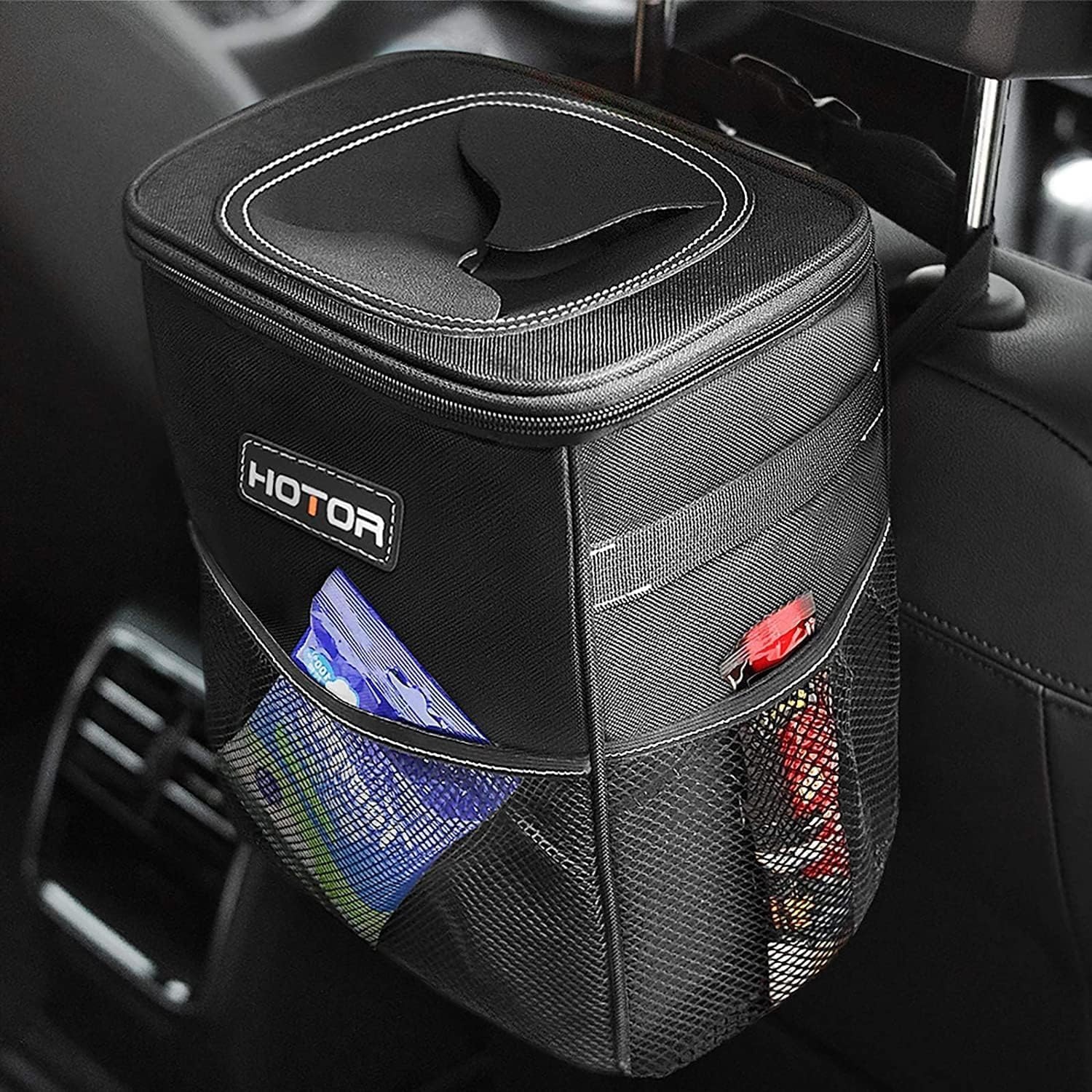
The HOTOR trash can is a soft-sided, compact solution designed specifically for the kinds of messes that build up over time during daily driving. Its design focuses on convenience, flexibility, and practicality—without adding clutter to your car interior.
This model features a waterproof PEVA inner lining, which is particularly helpful for containing drink spills, melted ice, or food residue. Unlike standard fabric interiors that absorb moisture, this one can be easily wiped clean or even rinsed with water when needed.
The can’s Velcro lid gives you quick access when needed while also keeping unsightly garbage out of view and limiting odors. This is especially useful if you often leave trash in the car overnight or take long trips where cleanup isn’t immediate.
A standout feature is the addition of side mesh pockets. These pockets make it easier to store small items like extra plastic liners, tissues, or even hand sanitizer—so you can manage minor messes as they happen.
In terms of installation, HOTOR includes adjustable, reinforced straps that allow you to mount the trash can in a variety of positions: on the back of a headrest, hanging from a center console, or near the gear shift. It doesn’t require any permanent fixtures or tools, which makes it a solid choice for renters or anyone who drives different cars regularly.
While the HOTOR trash can has a flexible shape that allows it to fit snugly in tight spots, one downside is that it doesn’t hold its form well when empty. However, it performs exceptionally well once in use, especially for drivers who want a leak-resistant, portable trash solution that won’t take up much space.
Lusso Gear Leakproof Car Trash Bin with Magnetic Lid
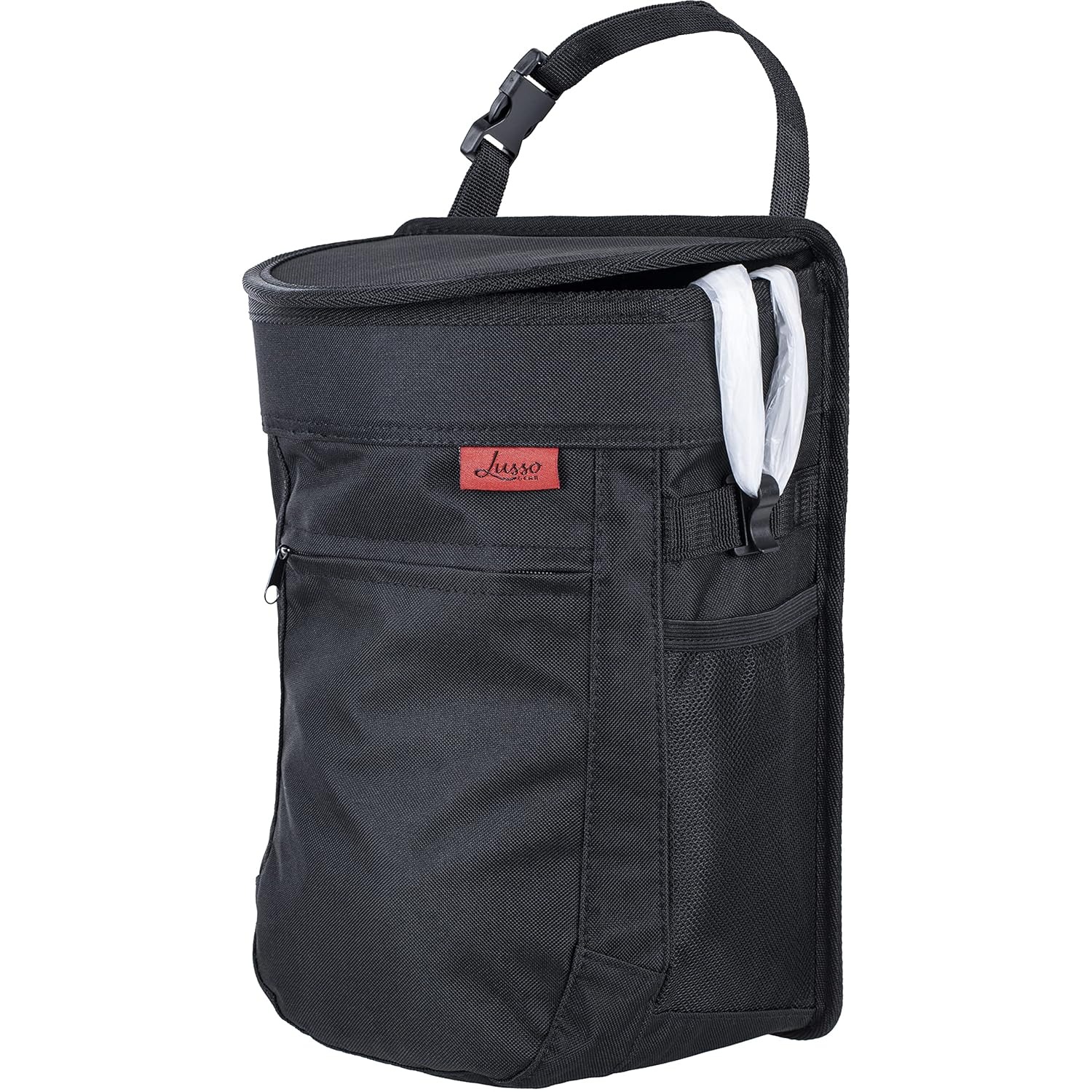
Lusso Gear offers a more structured take on car trash storage, aimed at those who prefer something that holds its shape, looks clean, and doesn’t require much adjusting.
Unlike soft-sided models, this bin features rigid internal panels that help it stay upright, even when empty. This is especially useful if you plan to use it on the floor between seats or in a spot where it can’t be securely strapped in. The firm structure means you won’t have to fumble to open it, and it won’t fold in on itself when you’re trying to toss something in quickly.
One of the most convenient features is the magnetic flip-top lid, which strikes a good balance between ease of access and odor control. You can open it with one hand, which is important for drivers who don’t want to be distracted while tossing in a receipt or food wrapper. At the same time, the lid stays closed during movement and helps block unwanted smells from lingering in the cabin.
The interior is lined with a durable, waterproof material that’s easy to wipe clean. Lusso Gear includes a few reusable liner bags, which can be removed and rinsed when full—ideal for those who prefer not to rely on disposable plastic bags.
The trash bin’s non-slip base panel and included securing strap help it stay in place even during sharp turns or sudden stops. It fits best between seats or against a console and is compact enough not to intrude into legroom.
Aesthetically, it has a minimalist design that blends into most car interiors without drawing attention. It looks more like an intentional part of your car than a loose accessory.
This model is especially well-suited for those who want a stable, easy-to-maintain bin that can handle a bit more weight and stand up to regular use. It’s also a solid choice for anyone who shares a vehicle and wants something reliable and neat.
Mini Car Vacuums – Crumbs, Dirt, and Dust Control
It doesn’t take long for the inside of a car to start collecting debris—especially if you regularly drive with kids, pets, or even just a morning pastry. Crumbs fall between seats, dirt gets tracked in on shoes, and dust collects on the dashboard. While most people think of vacuuming as a “cleaning day” chore, having a compact car vacuum can help you manage the mess before it builds up.
Mini car vacuums are specifically designed for this kind of maintenance. They’re small, portable, and easy to store in the glove box or trunk. Instead of letting the dirt pile up until it requires a deep clean, you can handle it in seconds—right after the mess happens.
When a Mini Vacuum Makes Sense
You don’t need a heavy-duty shop vacuum to keep your car clean. In fact, those are often overkill. A small, handheld vacuum is enough to clean up:
Sand and dirt after a trip to the park or beach.
Pet hair that clings to seats and carpets.
Crumbs under the seats from quick lunches or snacks.
Fine dust that collects on dashboards, vents, and cup holders.
Using a mini vacuum regularly keeps your interior looking fresh and reduces the chance of smells and buildup in hidden corners.
Corded vs. Cordless Models
There are two main types of mini car vacuums:
Corded vacuums plug into your car’s 12V outlet (cigarette lighter port). These are generally more powerful and have unlimited runtime, but you’re tethered by the cord, which can be limiting in larger vehicles.
Cordless vacuums use rechargeable batteries, giving you full mobility to reach every corner, including the trunk. However, they usually offer shorter run times and require regular charging.
Choosing between the two comes down to how often you plan to use it and whether you’re okay with managing battery life or prefer consistent power.
Key Features to Look For
When comparing models, keep these practical aspects in mind:
Strong suction power – Measured in watts or kilopascals (kPa). You’ll need enough power to pick up sand and fine dirt—not just surface dust.
Crevice tools and brush attachments – These help reach tight spaces like between seats or under pedals.
Easy-to-empty dust bins – A removable and washable bin saves time and avoids mess.
HEPA filters – These help trap allergens and fine dust, useful for sensitive passengers.
Noise level – Some models are much louder than others, which can be annoying in a small enclosed space.
Storage and Convenience
A good car vacuum should be compact enough to store easily in the trunk, under a seat, or in the back pocket of a seat cover. Look for models that come with a carrying bag or storage case to keep all attachments organized and easy to find.
If you keep up with quick vacuuming sessions once a week—or even once a month—you’ll avoid needing expensive professional detailing and your car will always feel a little more inviting.
THISWORX Car Vacuum Cleaner (Corded, 12V Plug-In)
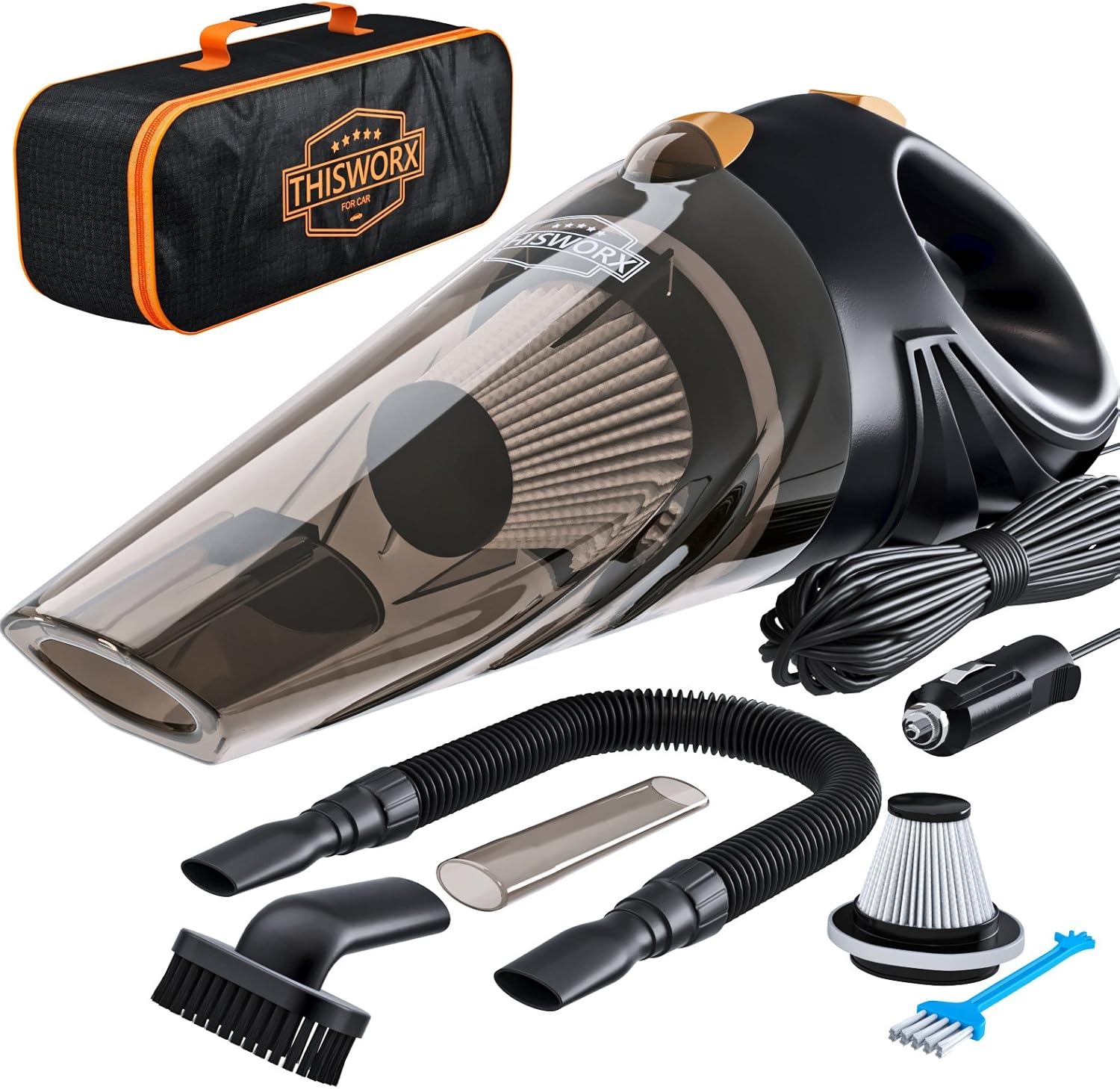
This compact vacuum is built specifically for vehicles, and it plugs directly into your car’s 12V outlet, which means you never have to worry about charging batteries or running out of power halfway through cleaning.
The suction power is strong enough to handle common car debris like sand, small gravel, food crumbs, pet hair, and dust. It operates at around 106W with solid airflow and includes a HEPA filter to capture finer particles, making it a good choice for people with allergies or pets.
One of the most useful aspects of this vacuum is the set of included attachments. It comes with a flat nozzle for narrow gaps (such as between seats), a brush nozzle for loosening dirt on upholstery, and an extension hose that helps reach under seats and into the trunk. The cord is over 16 feet long, which is more than enough to reach every part of most vehicles, including SUVs.
Emptying the dustbin is simple: it detaches easily, and both the container and filter are washable. While it’s not whisper-quiet, the noise level is tolerable and reasonable for a vacuum of this size.
It also comes with a zippered storage bag to keep everything together in your trunk or under a seat. This makes it easy to store without losing attachments or getting cords tangled.
Best for: Drivers who prefer a reliable, always-ready tool without having to worry about battery life. It’s especially handy if you often clean up pet hair, beach sand, or food debris and want consistent suction.
Lusso Gear Leakproof Car Trash Bin with Magnetic Lid

If you’re looking for cord-free flexibility, the AdvancedClean from BLACK+DECKER is a strong contender. While it wasn’t built exclusively for cars, it works well for car interiors thanks to its lightweight body and solid suction.
This model uses a lithium-ion battery that provides around 15–20 minutes of continuous use on a full charge. That’s typically enough to clean out the seats, floor mats, and trunk space in one go. It doesn’t match the power of a corded vacuum, but for light messes and regular upkeep, it’s more than capable.
One of its strengths is the pivoting nozzle and built-in crevice tool, which helps you reach between seat cushions and along tight edges. There’s also a flip-up brush for dusting vents or cleaning soft surfaces like dashboards.
The dust bowl is translucent, so you can see when it’s full, and it empties with a single button press. The filter and bowl are both washable, which helps keep maintenance simple and cost-free.
It charges via a base station (included), which can be left plugged in between uses. While not as powerful as a plug-in vacuum, it excels in convenience, and the cordless design makes it easier to do quick cleanups without dragging a cable across your seats.
Best for: Light users who want a fast, cordless option for touch-ups and spot cleaning. Ideal if your main concern is convenience and portability over maximum suction power.
Both vacuums serve different needs. If you prefer consistent performance and don’t mind using a cord, the THISWORX model gives you steady suction and a wide reach. If you value freedom of movement and quick cleanups, the BLACK+DECKER cordless model makes it easier to grab and go.
Power Inverters – Charging More Than Just Phones
Most people keep a phone charger in their car, but what happens when you need to charge something bigger — like a laptop, camera battery, tablet, or even a portable fan? That’s where a power inverter becomes a useful upgrade.
A car power inverter lets you convert your vehicle’s 12V DC power (from the cigarette lighter socket) into standard AC power, the same type you use in your home wall outlets. Many also come with USB ports, allowing you to charge several devices at once — even when you’re off-grid or stuck in traffic.
Why a Power Inverter Is Useful
You don’t need to be a road trip fanatic to benefit from one. These are helpful in more everyday situations than most people realize:
Working remotely from your car and needing to plug in a laptop.
Charging multiple phones or tablets when outlets aren’t available.
Powering a small heated blanket in winter or a fan in summer.
Running a small air compressor or car tire inflator.
Keeping kids’ tablets or portable game consoles charged during long drives.
Even if you’re not constantly using it, having one stored in the glove box or center console can save the day when your regular charger doesn’t cut it.
Key Things to Know Before Buying
Not all power inverters are the same. Choosing the right one depends on what you plan to plug in and how much power your devices need.
Here are the main features to consider:
Wattage output: Most inverters range from 150W to 500W for regular in-car use. For just charging phones and small devices, 150–200W is usually enough. If you want to power a laptop or small appliance, go for something higher, like 300W+.
AC outlets + USB ports: Look for a model with both — it gives you flexibility for different types of devices.
Cooling fan: Inverters with fans tend to last longer and are better for extended use.
Safety features: Overload protection, short-circuit protection, and low-voltage shutoff are important to protect your devices and your car’s electrical system.
Size and placement: Some are small and plug directly into the 12V socket, while larger ones have longer cables and can rest on the floor or console. Choose based on your car layout and how many people need access.
Limitations
Power inverters are not designed for large appliances. You can’t plug in a hair dryer or microwave — those would overload your car’s electrical system and the inverter itself. Stick to electronics, chargers, and low-wattage accessories that are car-friendly.
If you frequently find yourself needing more than just USB power, a compact inverter is a practical item to keep on hand. It won’t take up much space, but it can make your car feel a lot more functional — especially if you rely on your vehicle for work, travel, or just long commutes.
BESTEK 300W Power Inverter with Dual AC Outlets and USB Ports
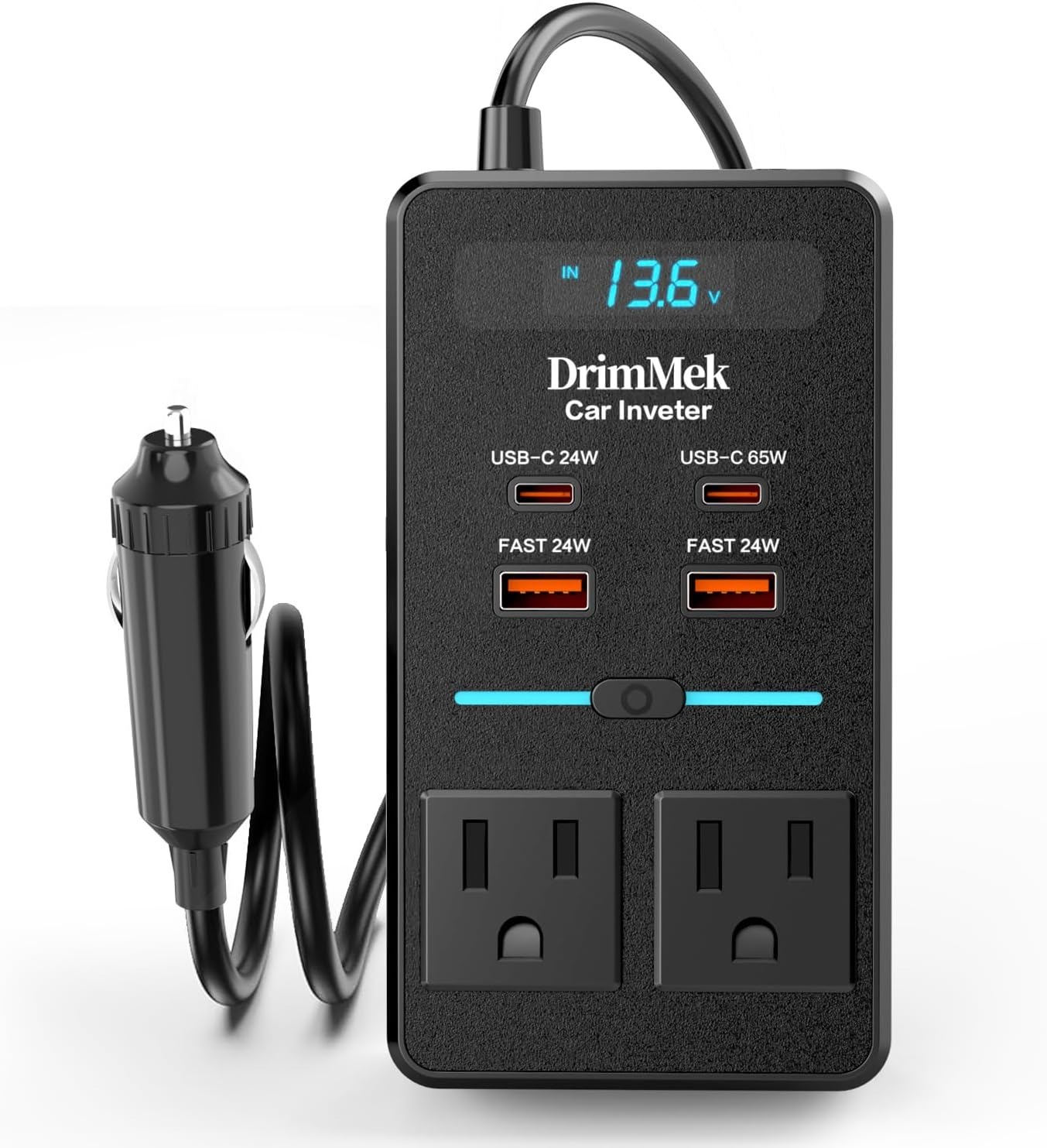
This compact vacuum is built specifically for vehicles, and it plugs directly into your car’s 12V outlet, which means you never have to worry about charging batteries or running out of power halfway through cleaning.
The suction power is strong enough to handle common car debris like sand, small gravel, food crumbs, pet hair, and dust. It operates at around 106W with solid airflow and includes a HEPA filter to capture finer particles, making it a good choice for people with allergies or pets.
One of the most useful aspects of this vacuum is the set of included attachments. It comes with a flat nozzle for narrow gaps (such as between seats), a brush nozzle for loosening dirt on upholstery, and an extension hose that helps reach under seats and into the trunk. The cord is over 16 feet long, which is more than enough to reach every part of most vehicles, including SUVs.
Emptying the dustbin is simple: it detaches easily, and both the container and filter are washable. While it’s not whisper-quiet, the noise level is tolerable and reasonable for a vacuum of this size.
It also comes with a zippered storage bag to keep everything together in your trunk or under a seat. This makes it easy to store without losing attachments or getting cords tangled.
Best for: Drivers who prefer a reliable, always-ready tool without having to worry about battery life. It’s especially handy if you often clean up pet hair, beach sand, or food debris and want consistent suction.
Foval 150W Car Power Inverter with AC Outlet and Dual USB Ports
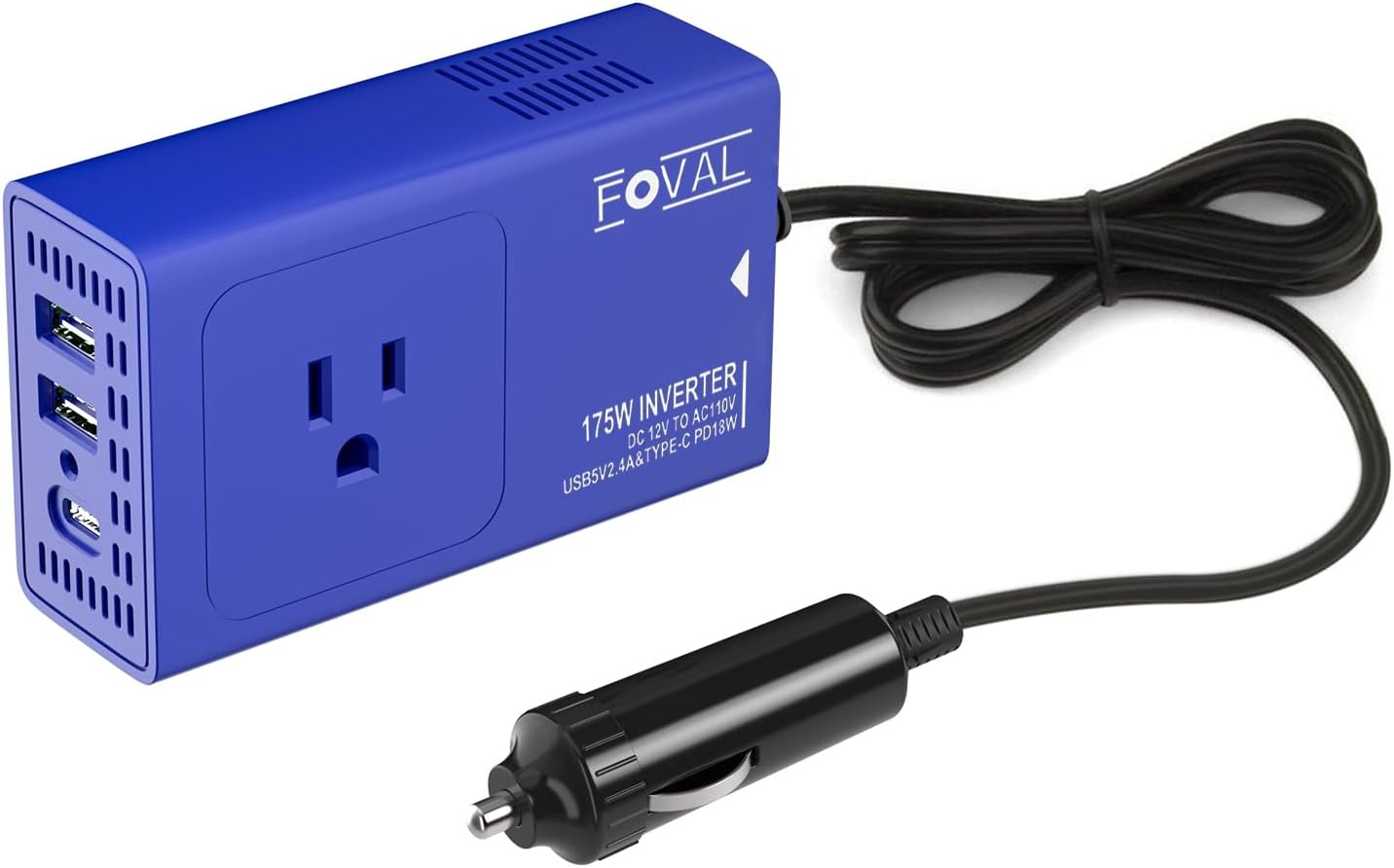
If you only need occasional charging for lighter devices and want something even smaller, this 150W inverter from Foval is a great low-profile choice. It plugs directly into your car’s 12V outlet and takes up very little space, making it ideal for drivers who don’t want extra bulk.
It provides one AC outlet and two USB ports. That’s enough to charge a laptop while also powering two smaller devices like a phone or tablet. The USB ports support fast charging, which is helpful if you’re trying to top off your phone before arriving somewhere.
While the 150W power rating isn’t suitable for high-demand electronics, it’s perfectly capable of handling daily essentials like:
Phone chargers
Tablets or eReaders
Bluetooth speakers
Small personal fans
Camera or drone batteries
The housing is aluminum alloy, which helps with heat dissipation, and the unit includes a cooling fan to extend lifespan. It also features built-in safety protections similar to the higher wattage models — so even at a lower price point, you’re not sacrificing safety.
What makes this one particularly convenient is its plug-and-go simplicity. There’s no extra cord to manage or store — just plug it in and you’re ready to charge.
Best use cases: Daily commutes, minimal setups, and anyone who wants a compact inverter they can just leave plugged in all the time for quick access.
If you regularly use multiple electronics in your car or need to power a laptop or DSLR battery charger, the BESTEK 300W is a more capable option. For more casual, space-conscious users who just want USB and occasional AC charging, the Foval 150W gets the job done with less footprint.
Seat Gap Organizers – Stop Losing Stuff Between the Seats
There’s a reason people call the space between the car seat and the center console the “black hole.” Once your phone, wallet, or keys slip down there, it often takes serious effort — and some awkward hand contortions — to get them back. It’s frustrating, distracting, and, depending on when it happens (like while driving), even unsafe.
Seat gap organizers are a simple fix to a surprisingly common problem. They’re not just for organization; they’re about convenience and safety, too.
What They Actually Do
These inserts slide into the narrow space between your seat and the center console to catch small items before they disappear. Some are designed just to block the gap, while others include compartments for storage — giving you extra space for things like your phone, wallet, sunglasses, or even a small water bottle.
While it might sound like a minor upgrade, this kind of organizer helps:
Prevent distractions while driving (no more fishing for dropped phones).
Keep your essentials within reach and not scattered around.
Create extra storage in cars that have limited compartments or cup holders.
Key Features to Consider
There are many styles, so it’s helpful to think about how you’ll use yours.
Basic gap fillers: These are foam or flexible blockers that stop items from falling between the seats. They’re often the easiest to install and work well if you don’t need extra compartments.
Organizers with storage: These sit in the gap but include slots, trays, or even cup holders to keep frequently used items in easy reach. Great for commuters or rideshare drivers.
Fit and compatibility: Some models are universal, but not all seats and consoles are spaced the same. Make sure the organizer is slim enough to fit your car without pushing your seat too far off-center or interfering with seat adjustments.
Material: Look for durable materials like PU leather, ABS plastic, or padded foam. These tend to hold their shape and match car interiors more seamlessly.
Installation: Most don’t require tools — they simply slide in. Some come with foam spacers or non-slip bases to help them stay put.
Things to Keep in Mind
If your car has a handbrake between the seats, some organizers may block it. Always check measurements before buying.
Tall or bulky organizers can interfere with seatbelt access or shifting — especially in smaller cars.
If you already have a tight fit between the console and seat, a slimmer gap blocker might be a better option than a full organizer.
Seat gap organizers don’t seem like a big deal until you use one — and realize how much smoother your daily routine becomes. No more dropped fries, missing change, or hunting for your phone at a red light.
Drop Stop Original Patented Car Seat Gap Filler
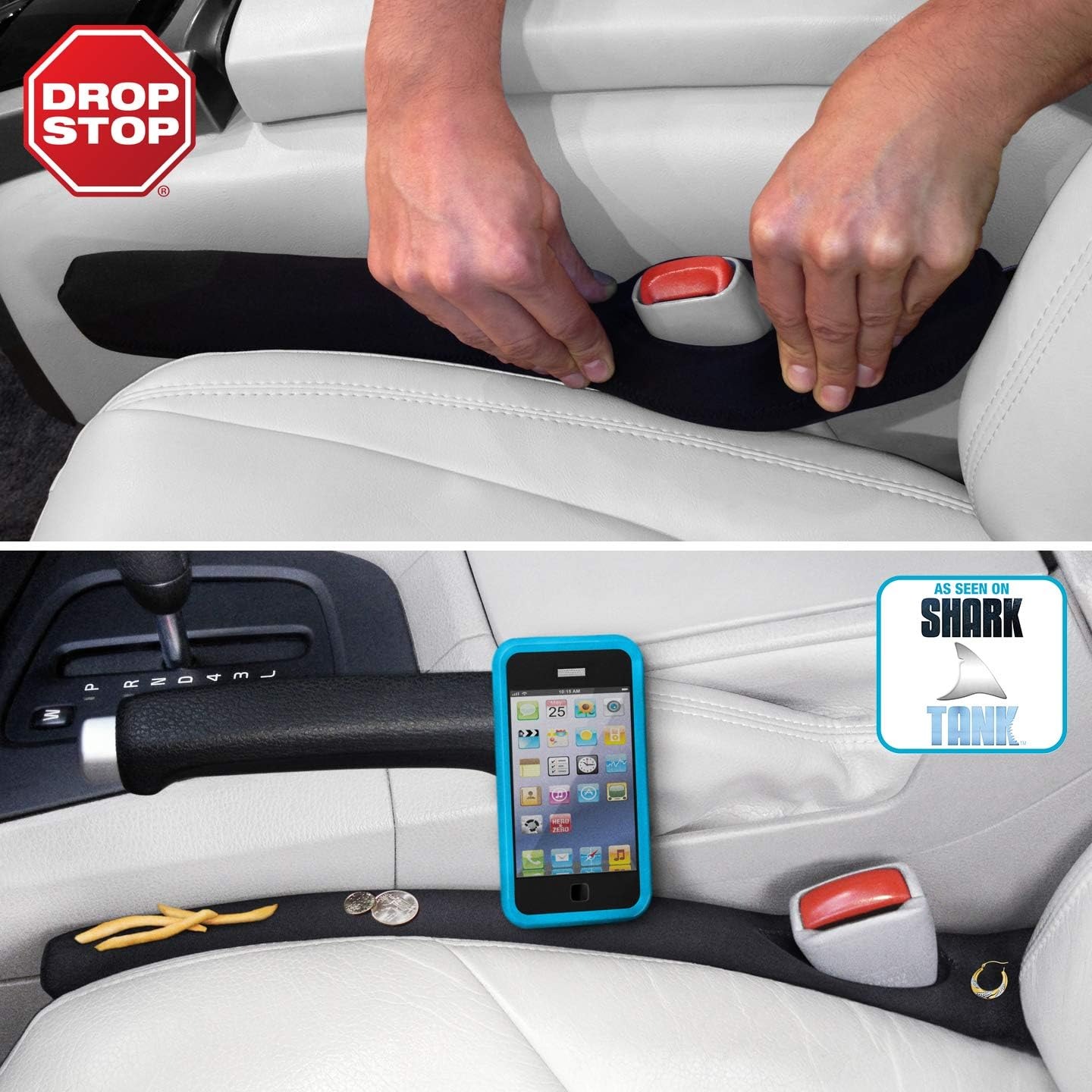
The Drop Stop is a simple, no-frills solution focused on safety and distraction prevention. It doesn’t offer storage or cup holders, but that’s intentional — it’s designed to stop anything from falling between the seat and console, and it does that job exceptionally well.
What makes it different from generic foam blocks is its universal fit and integrated design. Each piece has a small slit that allows it to fit around the seatbelt latch, so it doesn’t leave a gap behind. This means your keys, credit card, or phone can’t slip through — even in cars where the seatbelt is mounted in an awkward position.
The material is a high-grade neoprene, which is flexible enough to mold slightly to your seat shape but firm enough to stay in place. Unlike cheaper foam versions, this won’t lose its shape or get crushed over time.
It comes as a pair, one for each front seat, and doesn’t require any tools to install. You simply push each piece between the seat and the console, and you’re done. Once installed, you’ll barely notice them — until the day you drop your phone and it doesn’t disappear.
This is ideal if your main concern is stopping distractions while driving, and you don’t need extra compartments or organizers.
Lebogner Car Seat Gap Filler with Storage Console

If you’re looking to add functional storage while also solving the problem of falling items, this organizer-style gap filler offers both in a slim, practical design. It’s made from PU leather and fits snugly between the seat and the center console, giving you quick access to your phone, coins, receipts, pens, or sunglasses.
The inner compartment is divided into slots that are just big enough for everyday items you’d normally leave in the cup holder or door pocket. There’s also a dedicated slot sized for a phone or slim wallet, which helps reduce clutter elsewhere in the car.
Unlike bulky console inserts, this unit is relatively low-profile and doesn’t interfere with seatbelt use or shifting. However, since it adds width between the seat and console, it may be too snug for some cars with very little gap space. It works best in sedans, crossovers, or mid-size SUVs.
Installation is simple: just push it down into the seat gap. Some users add a thin piece of foam to tighten the fit, depending on the spacing in their vehicle. It doesn’t require adhesive or straps, so it’s easy to move or remove as needed.
This option is especially useful for drivers who want extra storage without modifying their vehicle interior, and who often carry small personal items that tend to float around the cabin.
Choose Drop Stop if your priority is keeping things from falling without changing your car layout.
Go with Lebogner’s organizer if you’d benefit from added storage and don’t mind a more visible insert.
Compact Tool Kits – Quick Fixes Without a Garage
Most people assume a car toolkit is only for serious mechanical problems. But in reality, you’ll probably use a compact tool kit for much smaller, more common issues — things that don’t require a mechanic but still need a quick fix on the spot.
You’re not trying to replace a transmission. But what about:
A loose screw on your license plate?
A headlight or tail light bulb that needs swapping?
A plastic panel or trim that pops loose?
Replacing a fuse, tightening a wiper blade, or checking a battery connection?
These small problems are annoying when you don’t have basic tools. That’s where a compact car tool kit can really save time (and frustration). It helps you take care of small issues before they get worse or leave you stuck at the wrong moment.
What to Look For in a Compact Car Toolkit
The best kits strike a balance between size and usefulness. You don’t need a full mechanic’s set — just something that covers the basics, fits in your trunk or glove compartment, and includes tools you’ll actually use.
Here’s what a practical, compact kit should include:
Screwdrivers – At least a flathead and Phillips; ideally, an interchangeable bit driver for small screws.
Pliers – Useful for gripping, cutting wires, or pulling small parts.
Adjustable wrench – Handy for tightening bolts or battery terminals.
Tape – Electrical or duct tape can be a temporary fix for wires or hoses.
Hex keys (Allen wrenches) – Needed for tightening interior or accessory components.
Small flashlight – A compact light source with batteries included can make a big difference in low-light situations.
Knife or box cutter – Good for packaging, zip ties, or trimming items on the go.
Cable ties – Temporary but extremely useful for securing loose parts or cables.
Fuse puller and spare fuses – If you’ve ever lost power to your stereo or charger port, this is an easy fix if you’re prepared.
Size and Portability
Most of these kits come in a zippered pouch or hard case, which makes them easy to slide under a seat or into your trunk’s side pocket. The goal is to be able to access it quickly when something happens — not to go digging through a box of random tools.
Kits with organized slots or labeled compartments also make it easier to find what you need fast — especially if you’re dealing with the issue in poor lighting or cold weather.
Important Considerations
Quality matters more than quantity. Many cheap kits have 50+ pieces but use soft metal tools that bend or break. It’s better to have 10 solid, usable items than 30 that fall apart.
Check what’s missing. Some tool kits include everything but skip over key items like tape or a flashlight — those are easy to add yourself.
Vehicle compatibility. While most tools are universal, some kits are designed more for general household use. Stick with one made for cars.
Even if you only use it a few times a year, a compact toolkit is one of those things you’ll be glad you have when something small goes wrong and you’re not near home.
WORKPRO 100-Piece Home/Auto Repair Tool Set with Carrying Case
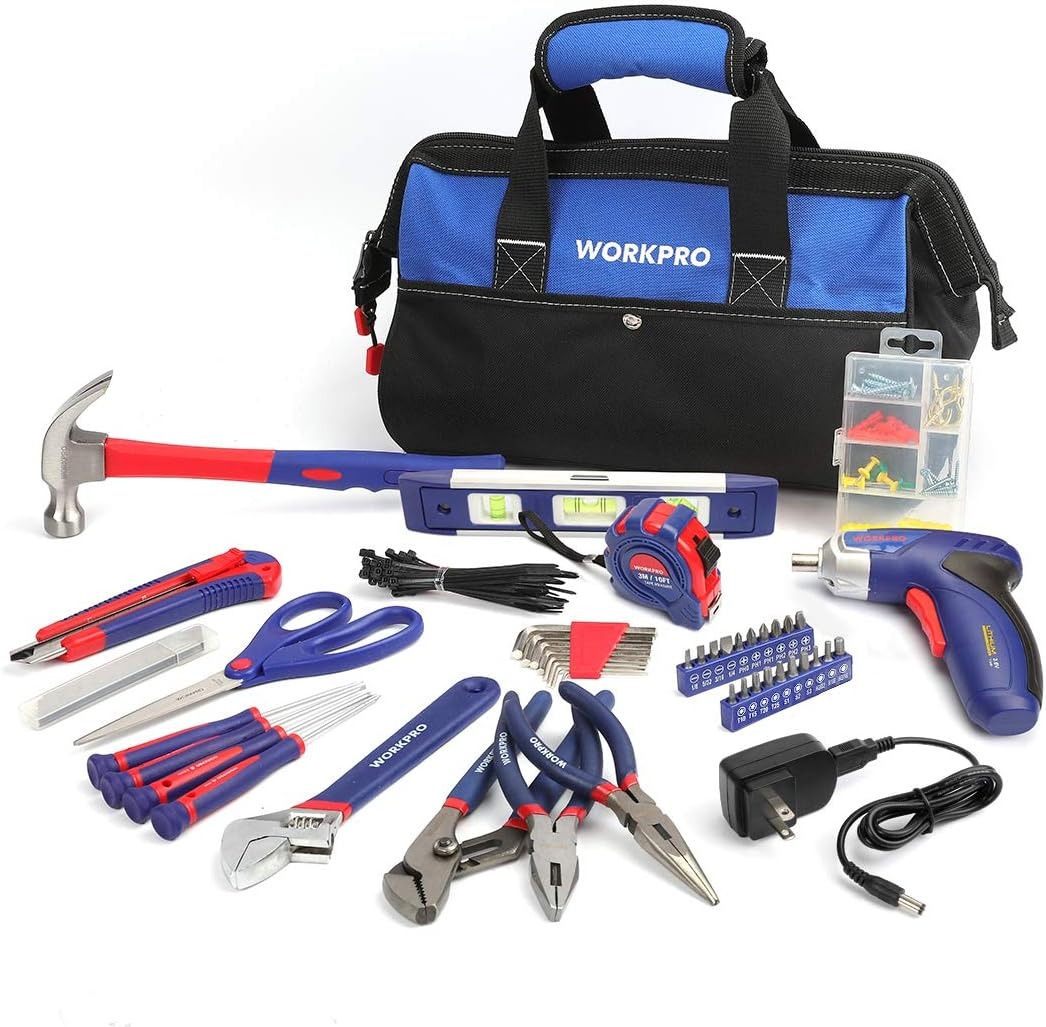
This kit offers a smart mix of basic hand tools that work well for car-related tasks, but it’s also versatile enough for small home fixes. It includes a solid variety of essentials — nothing overkill, just the most commonly used tools in one organized, portable case.
Inside the case, you’ll find:
An adjustable wrench that fits most common bolt sizes found in cars.
A bit driver with multiple bits (Phillips, flathead, Torx), which is useful for trim screws, battery terminals, and interior panels.
A pair of needle-nose pliers and a wire cutter — great for pulling fuses or dealing with minor electrical issues.
A voltage tester that comes in handy for checking battery leads or 12V socket functionality.
A utility knife, measuring tape, and electrical tape, all items that regularly come in handy in a pinch.
The blow-molded hard case keeps everything in place, so tools don’t rattle around in your trunk. While it’s not small enough to fit in your glove box, it fits easily in a trunk or under the rear seat of most vehicles.
Tool quality is surprisingly decent at this price range. It’s not professional-grade steel, but it’s more than strong enough for occasional fixes. Handles are rubberized and comfortable to grip, which makes a difference when working in tight car spaces.
Best for: Drivers who want a broader toolkit that works for both the car and home. Also a good option for beginners who don’t already own basic tools.
CARTMAN 39-Piece Tool Set with Case – Portable and Car-Friendly
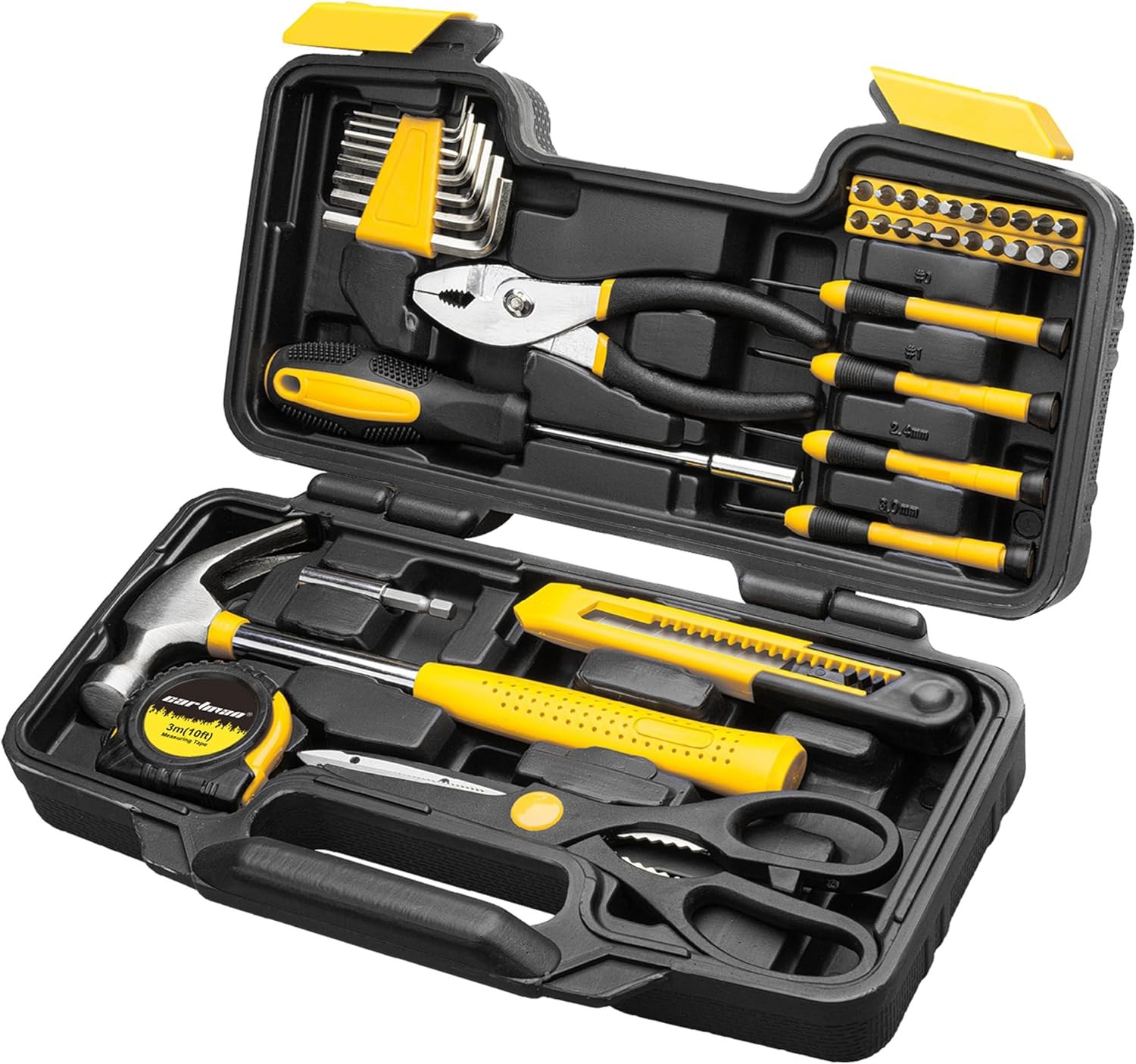
This is a scaled-down kit that focuses on car essentials only, without extra tools you likely won’t use in your vehicle. It’s built around the idea of emergency access — something you can grab quickly when needed without digging through a bigger toolbox.
It includes:
A compact bit driver with a wide selection of screwdriver heads — useful for everything from interior components to small battery covers.
Slip-joint pliers for quick gripping and turning jobs.
A basic socket set and mini ratchet for handling small bolts or removing plates.
Insulated tape, precision screwdrivers, and a flashlight — small but very functional when you need to inspect something in a dim trunk or under the hood.
A compact utility knife and cable ties, perfect for securing loose parts or cutting packaging in a hurry.
All of this comes in a small zippered case, about the size of a small book. It’s light, flat, and fits neatly in a glove box, door pocket, or under a seat.
This kit doesn’t include a wrench or multimeter, but it’s ideal for small electrical tasks, organizing cables, or tightening things that rattle. It’s meant to bridge the gap between being unprepared and needing a tow or a trip to the shop.
Best for: Anyone who wants a minimal, lightweight emergency tool kit that’s easy to store and designed specifically with vehicles in mind.
The WORKPRO 100-piece set is a more complete toolkit for car and home use, better suited for your trunk.
The CARTMAN 39-piece set is lighter, more compact, and focused on quick car fixes — ideal for glove box or emergency use.
FAQ: Everyday Emergency Items for Your Car
This section answers common questions drivers have when deciding what to keep in their vehicle — especially when it comes to small tools and gadgets that make everyday driving smoother and less frustrating.
It depends on your car layout, but here are general tips:
Glove box: Good for small items like a flashlight, spare fuses, or a mini toolkit.
Center console: Ideal for items you need often — charging cables, wipes, pens, tire pressure gauge.
Under seats: Slim toolkits, trash bins, or organizers can tuck under the seat if space allows.
Trunk: Best for larger toolkits, vacuums, or less frequently used items like jumper cables or a larger power inverter.
Door pockets: Great for quick-access items like tissues, snacks, or small trash bags.
The key is to keep things secure so they don’t slide around or become hazards during sharp turns.
If you’re someone who vacuums weekly with a shop vac or pays for detailing regularly, maybe not. But a mini vacuum is all about maintenance between cleanings. It helps keep crumbs, dirt, and pet hair from building up to the point where a major cleanup is needed.
Plus, it’s a lot easier to do quick spot cleaning after a messy snack or beach day — especially when you don’t want to drag out full-size cleaning gear.
No — power inverters are meant for low-wattage devices, like laptops, phone chargers, or small electronics. You can’t safely use them for hairdryers, space heaters, or other high-draw appliances.
Check the wattage rating on your inverter and your device’s power requirements. Most car-friendly inverters are in the 150W–300W range, which is plenty for phones, tablets, small fans, or camera chargers — but not much beyond that.
Not always. Most organizers are designed to be universal, but if your vehicle has very narrow or wide seat gaps, or an unusual center console shape, fit may vary.
Before buying, measure the space between your seat and console, and check product dimensions. Slim foam blockers fit almost any car, while bulkier organizers with storage compartments may not work well in tight spots or if they interfere with seatbelt buckles or handbrakes.
It’s a good habit to do a quick check every couple of months. Toss out used trash liners, check if your flashlight batteries still work, and make sure any tape, tools, or chargers are still where they belong.
Also, if you share your car with others, it’s worth making sure things haven’t been moved, used, or removed without your knowledge.
Unless you’re a mechanic or planning long road trips in remote areas, a compact kit is usually enough. Full-size kits are heavy, take up trunk space, and aren’t necessary for small repairs or everyday fixes.
If you regularly handle your own maintenance or drive through rough terrain, a more robust set might make sense. But for most drivers, a smaller, well-stocked kit covers the basics.
They’re absolutely worth it if you ever eat, drink, or have passengers in your car. A small, leakproof bin takes up less space than loose wrappers, bottles, and tissues scattered around. It also encourages a cleaner, more organized car — especially on road trips or commutes.
Just make sure to get one that fits your vehicle’s layout and attaches securely.
Cable ties and a flashlight. Two of the most useful, overlooked items for small emergencies. Cable ties can temporarily hold almost anything in place (a bumper, a hanging cord, a loose panel), and a flashlight helps in every kind of low-light situation — from reading something at night to fixing a fuse in the dark.
Conclusion: Small Tools, Big Difference
You don’t need a trunk full of gear to be prepared for everyday car troubles. Most of the time, it’s the small, annoying problems — not the major breakdowns — that catch you off guard. A spilled drink with no napkin, a dead phone with no charger, a lost key between the seats, or crumbs that just won’t go away.
The good news? These problems are easy to prevent with a few smart additions to your car.
A compact trash can keeps your space clean and manageable.
A mini vacuum helps you stay ahead of the mess.
A power inverter makes sure your devices stay charged on the go.
A seat gap organizer saves time and sanity.
And a small toolkit? That can turn a headache into a quick fix.
What’s more important is that none of these items are bulky, expensive, or difficult to use. They don’t require mechanical skills or hours of setup — they just work when you need them.
Instead of reacting to problems after they happen, you’re ready before they start.
If you drive daily, share your car with others, or just want to make your vehicle a little more functional and frustration-free, consider building your own kit using a few of these tools. It’s not about over-preparing — it’s about making your life easier, cleaner, and less stressful every time you get behind the wheel.
